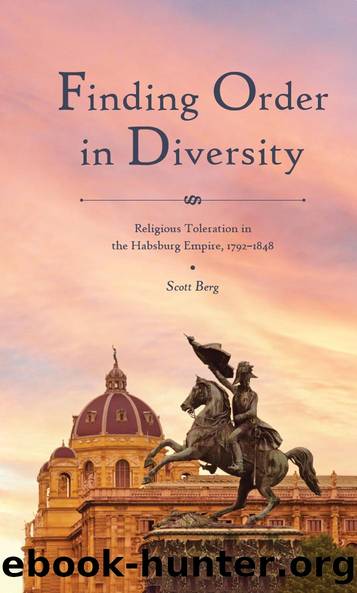Finding Order in Diversity: Religious Toleration in the Habsburg Empire, 1792â1848 by Scott Berg

Author:Scott Berg
Language: eng
Format: epub
Publisher: Purdue University Press
Published: 2021-12-15T00:00:00+00:00
RADICALS DURING THE SPRINGTIME OF NATIONS, MARCHâOCTOBER 1848
In this atmosphere, the Catholic reaction was divided, with the Josephists opposing involvement in political activities, activists agitating for Catholic freedoms, and radicals unconditionally supporting the revolution. In this environment, confessional politics entered the public arena, though the state apparatus continued compiling reports and making decisions on matters such as conversions until April 1848.12 The Pillersdorf constitution provisionally governed religious affairs, with Article XVII vaguely promising âfull freedom of belief and conscience.â13 In the meantime a parliament in Vienna tried to anchor a permanent, comprehensive set of regulations regarding the confessions of the empire.
Revolutionaries considered ecclesiastical issues a secondary matter, for the Catholic Church had been tame in the Habsburg lands in the decades before 1848, and Liberals focused on tax reform and access to state power.14 Petitions thus largely ignored religious issues. One well-known petition, âSuggestions of Austrian Citizens for Reform of State Administration on the Lines of Legal Progressâ (Vorschlädge der österreichischen Bürger zu einer Reform der Staatsverwalung im Sinne des gesetzlichen Fortschritts), in early March vaguely mentioned religious tolerance in one line in point 7, the smallest article in the petition.15 In Styria, point 6 of a March 15 petition demanded a similarly vague âfreedom of conscience,â and point 25 demanded the expulsion of the Jesuits.16 While revolutionaries embraced the image of Joseph II, marching past his statue in Josefsplatz in Vienna and sending an honor guard to protect it, this act was more a tribute to his relatively lenient stance on censorship than to his Church reforms.17
Even among radicals in Vienna, religious radicalism was a fringe element, and the radicals restricted themselves to attacks on the Jesuits, who were already illegal in Vienna (see chapter 1).18 Radicals invoked the name of God, and some even claimed to be Catholics. In fact, many of the Viennese students protesting in March attended mass before streaming into the streets calling for revolution. A petition by the âprogressive partyâ in Austria praised the pope, who âas the head of the oldest Christian Church, has begun the first crusade against the suppression of our freedom.â19 In a pamphlet, Friedrich Unterreiter argued that âthe dependence of Austria and Germany on the Roman See has always been a curse.â But even Unterreiter noted, âI am a Christianâa genuine Catholic Christian ⦠among the Catholic clergy I have known very fine men.â20 Although mobs occasionally damaged property, such as the plundering of the Mariahilferkirche on March 14, most churchmen and property remained unmolested.21 One exception was the Jesuits, who were frequent targets of vitriol in pamphlets. Attacks on monks resulted in a ban on the Jesuits and Redemptorists, and a wagon dropped Redemptorists off in Ottakring, a suburb outside Vienna.22
The archbishop of Vienna, Vincent Eduard Milde, was another target of the radicals. After Milde punished a student for staying out past curfew on April 5, a mob treated Milde to several nights of Katzenmusik, and weeks later, he fled to a castle in Kranichberg, where he hid not only from radicals but also from Catholics wanting his blessing on various projects.
Download
This site does not store any files on its server. We only index and link to content provided by other sites. Please contact the content providers to delete copyright contents if any and email us, we'll remove relevant links or contents immediately.
| Africa | Americas |
| Arctic & Antarctica | Asia |
| Australia & Oceania | Europe |
| Middle East | Russia |
| United States | World |
| Ancient Civilizations | Military |
| Historical Study & Educational Resources |
Never by Ken Follett(2869)
The Man Who Died Twice by Richard Osman(2289)
Machine Learning at Scale with H2O by Gregory Keys | David Whiting(2263)
Fairy Tale by Stephen King(2058)
Will by Will Smith(2032)
Rationality by Steven Pinker(1759)
The Dawn of Everything: A New History of Humanity by David Graeber & David Wengrow(1564)
The Dark Hours by Michael Connelly(1562)
Principles for Dealing With the Changing World Order: Why Nations Succeed and Fail by Ray Dalio(1368)
Friends, Lovers, and the Big Terrible Thing by Matthew Perry(1320)
A Short History of War by Jeremy Black(1295)
HBR's 10 Must Reads 2022 by Harvard Business Review(1251)
Go Tell the Bees That I Am Gone by Diana Gabaldon(1231)
Can't Hurt Me: Master Your Mind and Defy the Odds - Clean Edition by David Goggins(1218)
515945210 by Unknown(1205)
Fear No Evil by James Patterson(1103)
443319537 by Unknown(1069)
Works by Richard Wright(1017)
Going There by Katie Couric(987)
